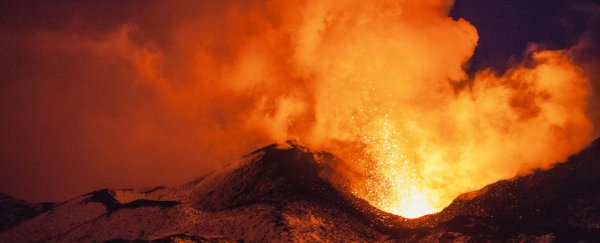Sixty-six million years ago, something changed the world catastrophically. Around 75 percent of the world's plant and animal species died, wiping out the dinosaurs. This marked the end of the Cretaceous period, and started a new dawn on Earth - the Cenozoic, the age of mammals.
But we don't entirely know what caused it. Fossil and geologic records show turbulent times spanning a million years - a giant asteroid impact and intense volcanic activity that spread out across the globe. But their relationship to each other, and to the extinction event, is unclear.
Now geologists have found a more precise date than ever for the Deccan Traps - volcanic lava flows that cover a region at least 500 kilometres (310 miles) across in India.
"Now that we have dated Deccan Traps lava flows in more and different locations, we see that the transition seems to be the same everywhere. I would say, with pretty high confidence, that the eruptions occurred within 50,000 years, and maybe 30,000 years, of the impact, which means they were synchronous within the margin of error," said planetary scientist Paul Renne of UC Berkeley's Geochronology Center.
"That is an important validation of the hypothesis that the impact renewed lava flows."
We know that the Deccan Traps were active for a span of about a million years. We also know that an asteroid slammed into Earth sometime during this time, creating the Chicxulub Crater under Mexico. But tying these events to the dinosaur extinction has been tricky.
Previously, geologists had thought that around 80 percent of the lava flow had occurred prior to the asteroid impact, which coincides with the mass extinction. Based on new, more precise dating, the team has demonstrated that this was not the case.
Instead, their data shows that the eruptions rumbled pretty low-key for around 400,000 years prior to the impact date. After the impact, they escalated: around 75 percent of the lava flows occurred in the 600,000 years after the impact.
So this means we need to rethink the roles of both events.
We already know the devastating effects that intense volcanic activity can have on life. It's responsible for the greatest mass extinction in Earth history, as well as some pretty unpleasant times after humans arrived on the scene, due to the changes volcanoes wreak on climate.
But the assumption with the Cretaceous-Paleogene extinction event had been that the release of greenhouse gases was related to volcanic eruption volume. The volcanoes erupted, spewed out most of their carbon dioxide, methane, and sulphur dioxide; then, the asteroid hit, boom, everyone was dead.
Now this new result implies a different timeline of events.
If only 25 percent of the lava erupted prior to the impact, that could mean one of two things. The climate change was unrelated to the volcanic greenhouse gases; or the greenhouse gases leaked out of subterranean magma chambers, unrelated to lava flows.
We know this can happen. It's been observed in active volcanoes today, such as Etna in Italy and Popocatepetl in Mexico.
"We are suggesting," Renne said, "that it is very likely that a lot of the gases that come from magma systems precede eruptions; they don't necessarily correlate with eruptions."
So does that mean the asteroid played no role? Well, not necessarily. The thing was huge. It left the world's second-largest known impact crater, 150 kilometres (93 miles) in diameter.
Although it was half a world away from the Deccan Traps, the timing can't be ignored. The team believes it triggered earthquake activity that kicked the Traps into high gear, delivering a one-two punch to the ecosystem.
However, the last flood basalt eruptions ended millions of years ago. There's nothing comparable we can study in action today, so we have to piece together what evidence we have.
This can lead to contradictions - another study released at the same time has asserted, based on a different dating method (zircons between the lava flows, rather than the lava itself), that the eruptions occurred in pulses, rather than continuously, which would produce a different scenario again.
So we suspect we haven't heard the last of this fascinating debate. Especially since understanding the mechanisms of climate change and mass extinction could mean the ultimate survival of our species.
The team's research has been published in the journal Science.
